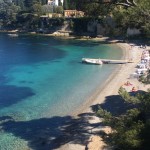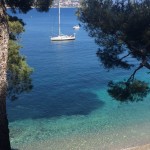Nice, France; The Cote d’Azur, Bus #81, cost 1 Euro, 50 centessime
Exploring European cities on the HOP ON, HOP OFF bus is great fun at a fair price. Sometimes a public bus, always featuring the HOP ON/OFF option, expands the adventure.
In Nice, France the city center terminus for Bus #81 is Place Garibaldi, a transportation hub on the north boundary of Nice’s in-city attraction – Old Town (Vieux Ville). Bus #81 makes thirty+ stops on its route along the Cote d’Azur, looping through Beaulie-Sur–Mer and twisting out the Cap Ferrat peninsula. The final stop, Terminus de ligne (end of the line in French) is St. Jean Cap-Ferrat; the legendary winter home to characters popular in early cinema. Palms, eucalyptus and citrus trees define the path of Bus #81.
Once aboard Bus #81, the first stop (Arret de bus) is the Port (Le Port), a square (Place) served by Brasseries and cafes. Passengers step aboard, clutch the overhead hand rail, Bus #81 departs Le Port. Motoring East, coiling along cliffs to the left, pebble beaches below to the right.
Bus #81 slows to a stop at Arret de bus # 10; the Batterie, Princess Grace. The doors open. A few meters from the bus, steps lead down to the Mediterranean; to the Harbor Villefranche. A voice only I can hear whispers in my left ear, “GET OFF HERE, GO EXPLORE.” It’s the same voice that poorly advised me in my teenage years; a voice I hadn’t heard for many years. The bus doors silently fold close. On towards Cap Ferrat.
28 minutes since departing Nice; Arret de bus #18. The sign on Boulevard Napoléon III advises this bus stop is MADONNE NOIRE. The bus doors draw open, unveiling a descending path down Avenue Clemenceau to the Cote d’Azur promenade. A uniformed waiter steps from a café delivering a pint of Kronenbourg 1664 blonde lager. The voice to my left again, “GET OFF HERE.” I’m still aboard as Bus #81 motors on.
Arret de bus #26, the Baie des Fourmis, a shaded pathway leads from the bus stop down to the beach, the Plage des Fourmis. Several attractive women are sun bathing topless along the water’s edge. I want to get off Bus #81, the voice says I should. But I stay.
Passable means tolerable in French. Passable is name of Arret de bus #30. Béatrice Ephrussi de Rothschild built her palazzo next to Bus Stop #30 in 1905. David Niven lived around the corner. Here the Cap Ferrat peninsula is just a quarter mile wide – the Mediterranean is in view out both sides of

Bus #81. Bus #81 stops, my inner voice begs me to get off Bus #81. I stay aboard.
Ten minutes to Port de Saint-Jean, the terminus de ligne for Bus #81.
Quotes from the locals
She sat on the wooden bench at the end of the line, Port de Saint-Jean, waiting for Bus #81 back to Nice. She could have been the woman Barry Manilow called Lola, “At the Copa, Copacabana.” Aging, blonde, wrinkled and rouged. She smiled, “Bonjour.”
Courteous introductions exchanged, she said, “My doctorate degree is in sociology with a focus on cinema pre-1950.” She was originally from Trieste, Italy; an Italian refugee living in Nice for the past twenty years.
“Italians eat better than the French,” she said. Bus #81 pulled up to the curb, doors unfolded. The Cap Ferrat crowd climbed aboard. She continued, “The infrastructure of France is much better than Italy because the French pay their taxes.” Bus #81 departed for central Nice, gliding above the Bay des Fourmis, a harbor on Cap-Ferrrat’s eastern Cote d’Azur shoreline. Stop, bus doors quickly open; the inner voice to my left whispers “COME FORTH.” I stay on Bus #81.
The rougey, wrinkled woman continued, “The US welcomes all people, here in France immigrants remain separate.” Bus #81 reached the Saint Aignan stop, she exits while concluding loudly, “I’m leaving France, relocating to LA, that’s my kind of town. Au revoir.” Bus #81 pulls away.
Why this place appeals to me
The Rose wine of Provence; chilled and served mid-afternoon on a terrace.

A 1.6 kilometer gravel path circles Pointe de Saint-Hospice at the tip of the Port Saint Jean peninsula; the Prom des Fossettes. The Prom ends at Anse des Fossettes. The April sun had warmed to 63 degrees, the pebbles of the beach must have been warmer as 20 bodies lay sunning on along the Mediterranean facing west, looking at the Harbor de Villefranche.
To reach the Prom des Fossettes from Saint Jean, walk SE down Ave Jean Mermoz. Keep the marina on your left. Trudge up a slight hill past the Hotel D’Or. Ahead on your left you’ll look down on Paloma beach. Soon you’ll arrive at the small peninsula of St Hospice; a 5–10 minute walk from the port.
Cap Ferrat is open to visitors in the spring. Many villages along the Mediterranean in Italy have shuttered their doors, waiting for the throngs to arrive in July and August. Springtime along the French Riviera lacks of push & shove. Café hostesses greet you upon entry, wine appears as you are seated. In April it’s hard to deny yourself the 2nd midafternoon glass of rose.
How Far Down the Block? [mappress mapid=”16″]
The road from the port of Nice to Cap Ferrat is eight kilometers. It lies under the shadow of Mont Boron, along the road tracing the harbor of Villefranche sul Mer.
Why you might be nearby?
You are traveling the scenic route from Paris to Italy via the Cote d”Azur. Leaving Saint Jean the coastal road East leads through the tiny French village of Eze, the country of Monaco and on to Ventimiglia – Italy’s most northern city along the Riviera.
If you’re in Nice, Place Garibaldi, the departure point for Bus #81, is the hub of the city. Giuseppe Garibaldi, hero of the Italian unification, was born in Nice in 1807. Nice became part of the Kingdom of Piedmont-Sardinia (an eventual piece of Italy). The square, designated Place Garibaldi in September 1870, was built in the late 18th century marking the entry gate to the Nice and leading to the capital of Piedmont-Sardinia; Turin.
Garibaldi was fiercely in favor of Nice unifying with Italy. History books report that Nice was given to the French as political settlement. Niceans (Nice citizens) say that the locals were given a choice – and chose to be French.
Place Garibaldi, open only to pedestrian traffic, is a crossroads between the Vieux Nice (old town) and the town center.
Lesser Known Facts
The Cote D’Azur began as a winter escape for the northern Europeans. American expatriates created Cap Ferrat’s winter season in the 1920’s. World War I doomed France’s adherence to the gold standard supporting the French Franc. The Franc declined through the early 1920’s to 10% of its former value versus the US dollar. Expatriate Americans, on the smallest allowance, flocked to France

– declaring themselves writers or artists and living well. And unrestricted by prohibition denying them alcohol.
Something for Nothing
It cost 1Euro50 to ride bus #81 to Cap Ferrat. The ticket is valid for an unusual time of 74 minutes – the one-way bus trip requires 35 minutes, so theoretically your ride back to Place Garibaldi is gratis. But, not to explore Cap Ferrat by foot would be a venial sin; and you would have to confess to your friends back home and your fellow riders on the return bus #81 to Nice.
Abandon the concept of a free return trip on Bus #81. While small, Port Saint Jean requires a pause at a seafront café, a glass of something French and conversation with whoever is seated nearby.
